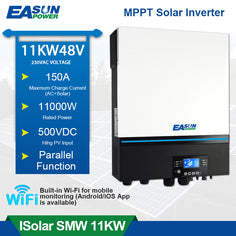Photovoltaic solar inverters play a crucial role in converting the direct current (DC) generated by solar panels into alternating current (AC) for use in homes and businesses. One of the key technologies that have revolutionized the efficiency of solar inverters is Maximum Power Point Tracking (MPPT). In this article, we will delve into the benefits of MPPT technology in photovoltaic solar inverters and understand how it has transformed the solar energy industry.

Enhanced Energy Harvesting
MPPT technology enables photovoltaic solar inverters to maximize the energy harvested from solar panels. By continuously tracking the maximum power point of the solar array, MPPT ensures that the inverter operates at the most efficient voltage and current levels. This results in a significant increase in energy production, especially in varying weather conditions and shading scenarios. In essence, MPPT technology optimizes the performance of solar inverters, leading to higher energy yields and improved overall system efficiency.
Improved System Flexibility
Another advantage of MPPT technology in photovoltaic solar inverters is the enhanced system flexibility it offers. With MPPT, solar inverters can adapt to changes in the solar array's operating conditions, such as temperature fluctuations and panel degradation, to maintain peak performance. This flexibility is particularly valuable in real-world solar installations where environmental factors can impact energy production. By dynamically adjusting the operating parameters, MPPT technology ensures that the solar inverter operates at its optimal point, regardless of external influences.
Fast Response to Dynamic Conditions
MPPT technology equips photovoltaic solar inverters with the ability to respond quickly to dynamic changes in solar irradiance. When clouds pass over the solar array or when the angle of sunlight changes, MPPT enables the inverter to swiftly adapt and maintain maximum power output. This rapid response to varying conditions ensures that the solar energy system operates efficiently, minimizing energy losses and maximizing the utilization of available sunlight. As a result, MPPT technology enhances the reliability and performance of photovoltaic solar inverters in diverse environmental settings.
Cost-Effective Energy Production
By harnessing the benefits of MPPT technology, photovoltaic solar inverters contribute to cost-effective energy production. The increased energy harvesting, improved system flexibility, and fast response to dynamic conditions translate into higher returns on investment for solar power plant owners and reduced electricity costs for end-users. MPPT technology optimizes the operation of solar inverters, allowing for the efficient utilization of solar energy resources and minimizing the payback period for solar installations. This cost-effectiveness is a compelling reason for the widespread adoption of MPPT technology in the photovoltaic solar industry.
In conclusion, the exploration of the benefits of MPPT technology in photovoltaic solar inverters reveals its transformative impact on the efficiency, flexibility, and cost-effectiveness of solar energy systems. As the demand for renewable energy continues to grow, MPPT technology will play a pivotal role in maximizing the potential of solar power generation. With its ability to enhance energy harvesting, improve system flexibility, respond to dynamic conditions, and enable cost-effective energy production, MPPT technology stands as a cornerstone of modern photovoltaic solar inverters.














